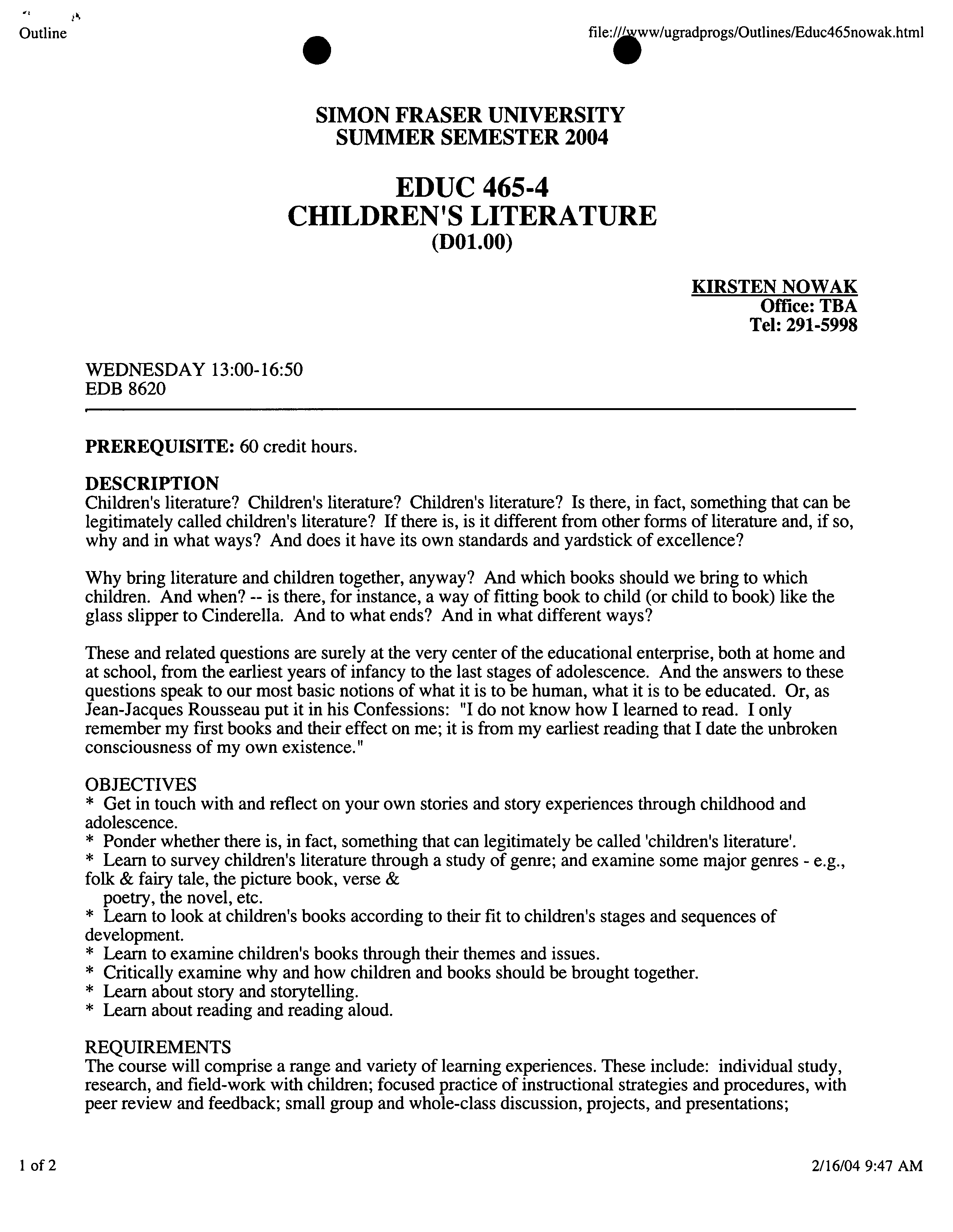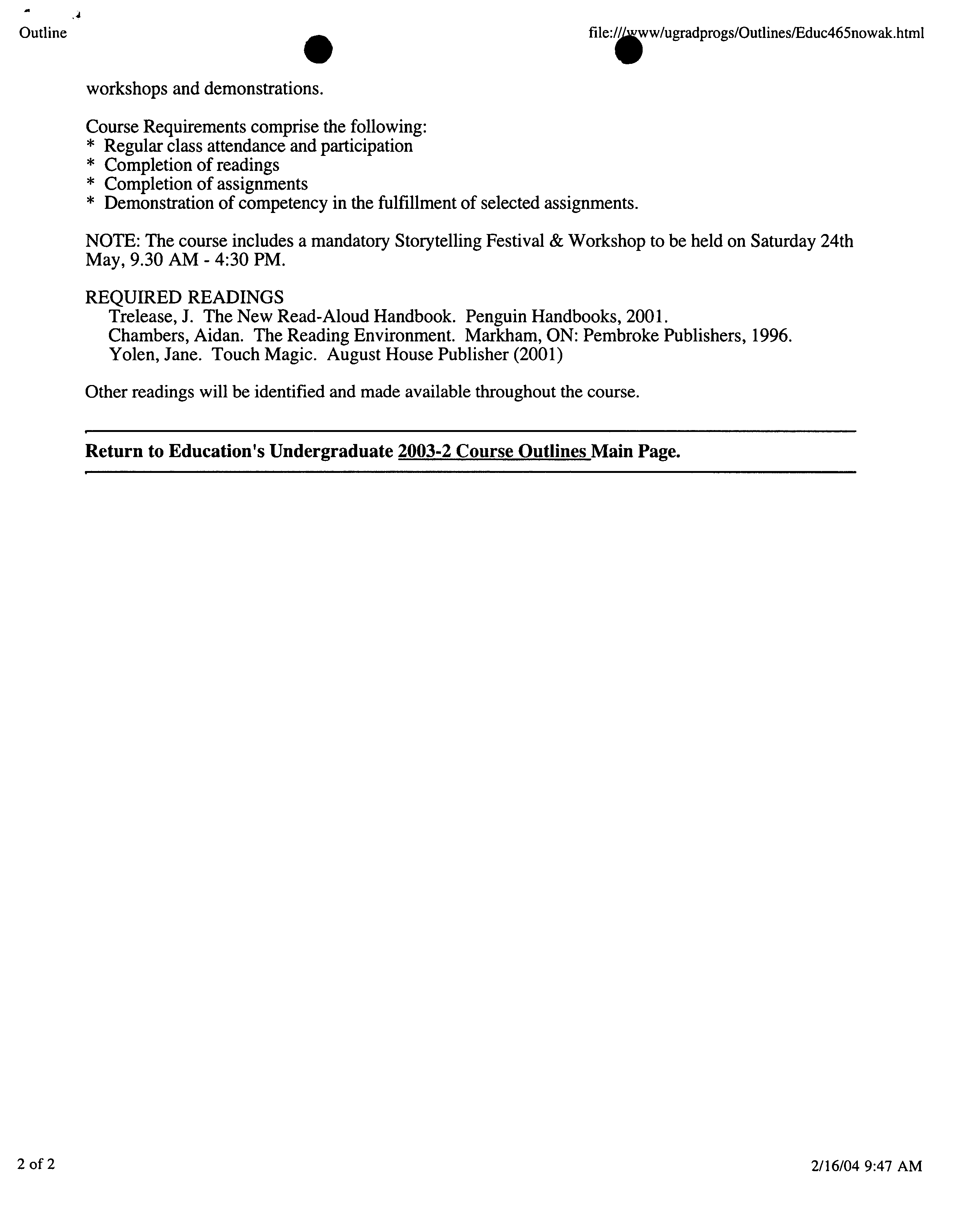Outline
?
file:!!' ww/ugradprogs/Outlines/Educ465nowak.html
SIMON FRASER UNIVERSITY ?
SUMMER SEMESTER 2004
EDUC
465-4
CHILDREN'S LITERATURE
?
(D01.00)
KIRSTEN NOWAK
Office: TBA
Tel: 291-5998
WEDNESDAY 13:00-16:50
EDB 8620
PREREQUISITE:
60 credit hours.
DESCRIPTION
Children's literature? Children's literature? Children's literature? Is there, in fact, something that can be
legitimately called children's literature? If there is, is it different from other forms of literature and, if so,
why and in what ways? And does it have its own standards and yardstick of excellence?
Why bring literature and children together, anyway? And which books should we bring to which
children. And when? -- is there, for instance, a way of fitting book to child (or child to book) like the
glass slipper to Cinderella. And to what ends? And in what different ways?
These and related questions are surely at the very center of the educational enterprise, both at home and
at school, from the earliest years of infancy to the last stages of adolescence. And the answers to these
questions speak to our most basic notions of what it is to be human, what it is to be educated. Or, as
Jean-Jacques Rousseau put it in his Confessions: "I do not know how I learned to read. I only
remember my first books and their effect on me; it is from my earliest reading that I date the unbroken
consciousness of my own existence."
OBJECTIVES
* Get in touch with and reflect on your own stories and story experiences through childhood and
adolescence.
* Ponder whether there is, in fact, something that can legitimately be called 'children's literature'.
* Learn to survey children's literature through a study of genre; and examine some major genres - e.g.,
folk & fairy tale, the picture book, verse &
poetry, the novel, etc.
* Learn to look at children's books according to their fit to children's stages and sequences of
development.
* Learn to examine children's books through their themes and issues.
* Critically examine why and how children and books should be brought together.
* Learn about story and storytelling.
* Learn about reading and reading aloud.
REQUIREMENTS
The course will comprise a range and variety of learning experiences. These include: individual study,
research, and field-work with children; focused practice of instructional strategies and procedures, with
peer review and feedback; small group and whole-class discussion, projects, and presentations;
1 of 2
?
2!16/04 9:47 AM
.4
Outline ?
file:!! ww/ugradprogs/OutlineslEduc465nowak.html
workshops and demonstrations.
Course Requirements comprise the following:
* Regular class attendance and participation
* Completion of readings
* Completion of assignments
* Demonstration of competency in the fulfillment of selected assignments.
NOTE: The course includes a mandatory Storytelling Festival & Workshop to be held on Saturday 24th
May, 9.30 AM - 4:30 PM.
REQUIRED READINGS
Trelease, J. The New Read-Aloud Handbook. Penguin Handbooks, 2001.
Chambers, Aidan. The Reading Environment. Markham, ON: Pembroke Publishers, 1996.
Yolen, Jane. Touch Magic. August House Publisher (2001)
Other readings will be identified and made available throughout the course.
Return to Education's Undergraduate 2003-2 Course Outlines Main Page.
2 of 2 ?
2!16/04 9:47 AM


